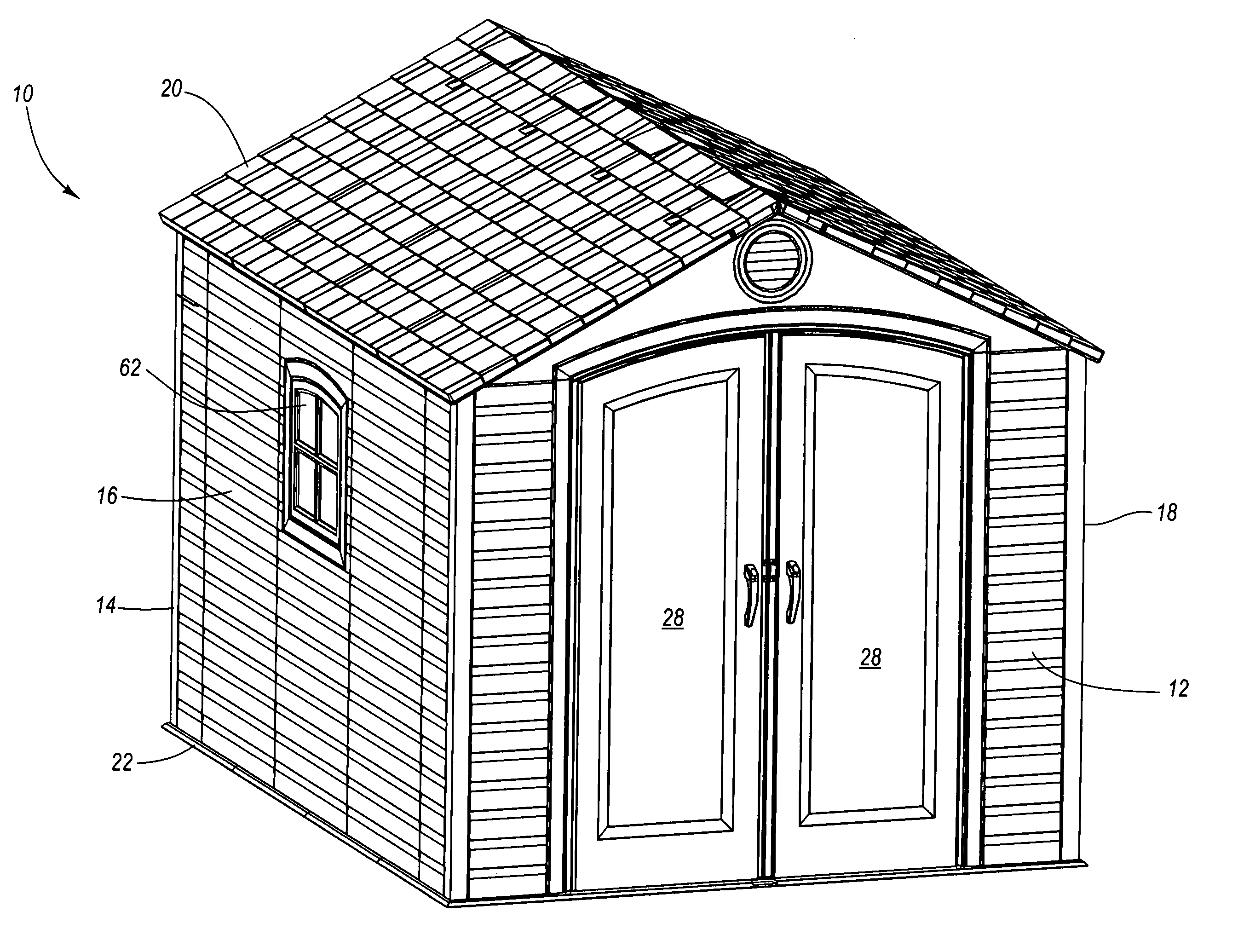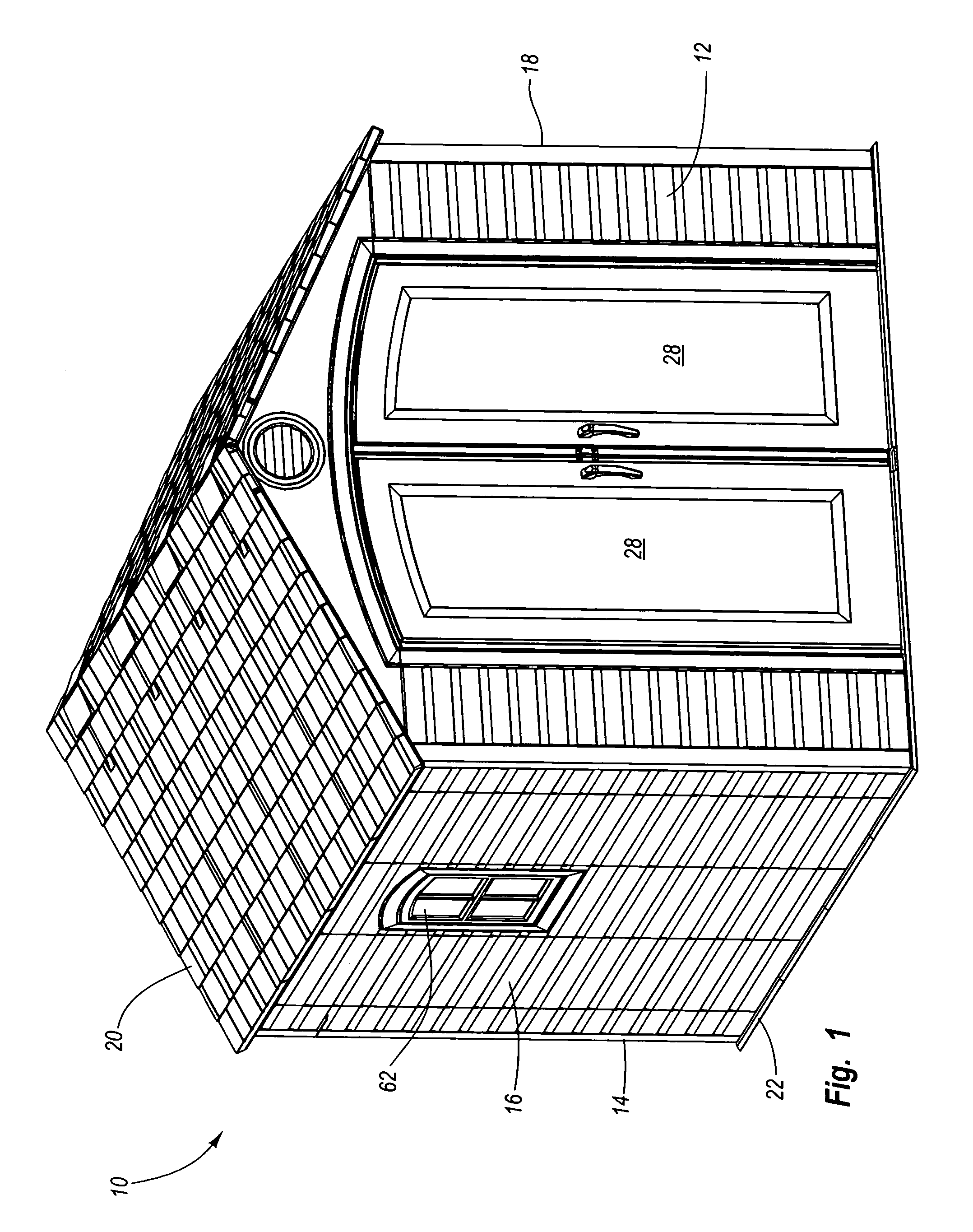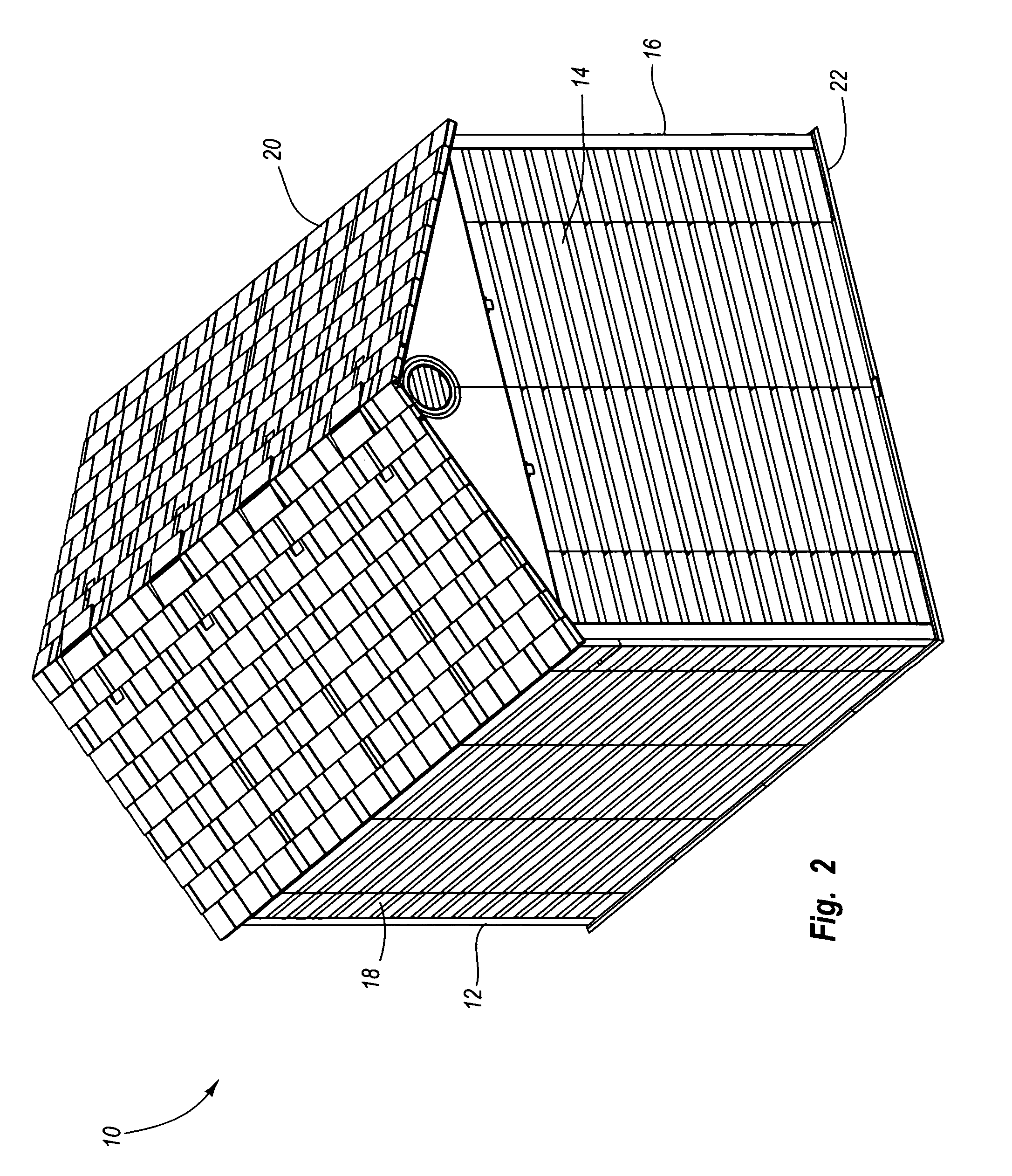Disadvantageously, conventional sheds often require a substantial amount of time, labor, skill and effort to build and construct.
The windows and vents of many conventional sheds, however, often require a number of interconnected components and are difficult to manufacture and install.
Additionally, many conventional sheds are difficult to repair, modify, change or rearrange because the sheds may be difficult or impossible to disassemble or dismantle.
Accordingly, it is often impractical or unfeasible to move or reconfigure many conventional sheds.
Wooden sheds, however, are relatively heavy and require a large amount of time to construct and assemble.
These numerous parts typically increase the costs of the shed and require a large amount of time and effort to construct the shed.
In addition, wooden sheds typically deteriorate over time and often require continual maintenance.
For example, conventional wooden sheds may be damaged by rotting or otherwise deteriorating when exposed to the elements.
In addition, the wood may warp or decay over time.
Undesirably, this may result in significant maintenance costs.
Disadvantageously, the sheet
metal is often flexible and easily damaged.
In particular, the sheet
metal walls may be damaged by forces being applied to either the inner or outer walls of the shed.
In particular, this may cause the walls to undesirably bow inwardly or outwardly and, in some circumstances, may create an opening in the wall.
Significantly, the damaged sheet metal may be more susceptible to
rust or
corrosion and the damaged sheet metal may be very difficult to repair or replace.
In addition, conventional metal sheds often require a plurality of screws or bolts to assemble the shed, which may increase manufacturing costs and the time required to assemble the shed.
Moreover, metal sheds often have a tendency to
rust and deteriorate over time, especially when exposed to the elements.
Thus, metal sheds may have to be painted or otherwise protected from rusting or oxidation.
The materials used to construct conventional sheds are often heavy and bulky.
Accordingly, many of the components are large and bulky.
In addition, if these components are constructed from wood or metal, then the components may be very heavy.
Thus, the components of conventional sheds may be large, awkward, heavy and generally unwieldy.
Many conventional sheds are shipped in an unassembled configuration because of their
large size in the assembled configuration.
The weight of the components, however, may result in significant shipping expenses and those expenses may be compounded every time the shed is transported or shipped.
For example, there may be significant costs when the manufacturer ships the shed to the retailer, which the
consumer may ultimately have to pay.
Many consumers may have to pay more to have the shed delivered from the retailer because of the weight of the packaging.
In addition, many consumers may be unwilling or unable to purchase these conventional sheds because they have no practical way of taking the shed home.
Specifically, many consumers are unable to lift or move the packaging of many conventional sheds.
In particular, the
consumer may also have to rent or borrow a forklift to load and unload the scourage m vehicle.
Accordingly, these large costs and difficulties in transportation may discourage many potential consumers from
purchasing conventional sheds.
In addition to conventional sheds being constructed from heavy and bulky materials and components, conventional sheds are often shipped in very large and heavy boxes.
These gigantic shipping boxes often will not fit in a typical retail
consumer's vehicle.
Accordingly, the size and weight of many known sheds is substantial, which may greatly complicate and increase the costs of shipping.
Accordingly, the shipping costs per shed (such as, from a supplier to a retailer) can be significantly increased.
Also, because these packaged sheds are so large and heavy, many shippers may find it difficult to efficiently deliver the sheds and may refuse to ship the sheds.
In addition, because many conventional packaged sheds are so large and heavy, they typically must be shipped to consumers using freight shippers, which may charge even more for these heavy, large and awkward boxes.
In some instances, this cost may be simply too large for a customer to justify the purchase.
Known storage sheds are also typically constructed of a variety of awkwardly shaped components, which can be difficult to ship and can be susceptible to damage if shipped.
In order to ship and protect these awkwardly shaped components, large amounts of packaging materials may be required.
The packing material, however, takes additional space in the packaging and the packing material increases the shipping costs.
In addition, because the components may be awkwardly shaped, custom packing materials may be required and the packing material may be irreparably damaged during shipping.
Thus, the packing material may not be reusable and may create a significant amount of waste.
Further, it may require a significant amount of time to prepare these awkward components for shipping, and this may increase labor costs and decrease
manufacturing efficiency.
Finally, the awkwardly shaped components often consume a large amount of area, which may increase the overall volume required to ship the shed and that may correspondingly increasing shipping costs.
Disadvantageously, these seams or joints are often susceptible to leaks.
For example, the seams or joints may allow water to enter the shed and the water can damage whatever is stored within the shed.
In addition, many sheds are subjected to a variety of
adverse weather conditions and some conventional sheds may be damaged if they are constructed from weak materials or poorly assembled.
For example, conventional sheds may be damaged by heavy winds.
Undesirably, the
snow may damage the roof and, in extreme circumstances, may cause the roof to collapse.
The flat roofs may also allow water and other objects to collect on the roof, which may damage the roof and / or leak through the roof and into the shed.
 Login to View More
Login to View More  Login to View More
Login to View More 


